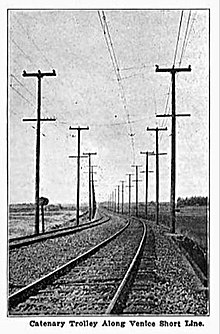Venice Short Line – Wikipedia
From Wikipedia, the free encyclopedia
Los Angeles streetcar route (1897-1950)
The Venice Short Line was a Pacific Electric interurban railway line in Los Angeles which traveled from downtown Los Angeles to Venice, Ocean Park, and Santa Monica via Venice Boulevard.
History[edit]
The part of the line from the Hill Street station to Vineyard was originally built in 1897 by the Pasadena and Pacific Electric Railway Company. The line from Vineyard to Venice was constructed in 1903 by Los Angeles-Pacific Railroad (LAP).[1] A controlling interest in LAP was sold to Southern Pacific interests in 1906,[2] whereupon the track gauge was converted from 42 inch to standard.[3] In 1911, LAP was consolidated into the new Pacific Electric Railway, which operated the line until rail service ended on December 28, 1950.[4][2][3][5] The route was thereupon converted to motor coach operations.[6][7] All rails had been removed or paved over by 1981.
The line originated in Downtown Los Angeles at the Subway Terminal Building. The Red Cars exited the station at ground level directly on to Hill Street. The dual tracks ran south in the middle of Hill Street crossing major intersections such as 6th Street, Olympic Boulevard, and Pico Boulevard until the line turned west onto Venice Boulevard.

On Venice Boulevard the dual tracks located in the middle of the paved street continued westerly passing major streets such as Figueroa, Hoover, and Vermont until the Berendo Street siding track which allowed passing of other Red Cars. Upon leaving the siding the tracks continued on the middle of Venice Boulevard passing Normandie and Western until the line reached Arlington Avenue. At Arlington the tracks then entered an unpaved private right of way in the center of dual roadways which ended at Crenshaw Boulevard. From Crenshaw Boulevard the dual tracks entered another section of private way located on the north side of Venice Boulevard and continued on to Vineyard Avenue. It was here that the Sawtelle Line branched northwesterly to Beverly Hills. Westerly of Vineyard Avenue, Venice Boulevard became a split roadway with the dual tracks located on private way between the roadways. The Venice Short Line continued westerly crossing over La Cienega Boulevard passing the Helms Bakery on its way to Culver Junction which is westerly of Exposition Boulevard. It is at the Junction that the Redondo Beach via Playa del Rey Line branched southwesterly and the Santa Monica Air Line crossed.
The dual tracks continued westerly from the Junction on unpaved private way in the center of Venice Boulevard passing intersections such as Overland Avenue, Sepulveda Boulevard, Centinela Avenue, Lincoln Boulevard, and Washington Boulevards. The line then crossed the Grand Canal in Venice on a concrete arch bridge and turned north onto Pacific Avenue. After the line’s closure, the right of way in the center of Venice Boulevard sat vacant, and was used as an unpaved parking lot. In the 1970s Venice Boulevard was reconfigured, straightening the roadway and converting the derelict right of way into vehicle travel lanes and a median. Traces of the former alignment remain just east of Overland, where sidewalks and buildings along the north side of Venice Boulevard align to the old width of the road, with the space between the old and new roadway filled in with parking lots.
The double tracks then ran on the pavement of Pacific Avenue[8] for five blocks before entering a wide private way known then as the “Trolleyway”. From windward Avenue in Venice the line followed the “Trolleyway” north, past the Ocean Park Carhouse and yard, through Ocean Park to Pico Boulevard where the “Trolleyway” ended and street running resumed directly into Ocean Avenue. The tracks then followed Ocean Avenue north to the terminus of the Venice Short Line at Broadway in Santa Monica. Following the abandonment of the line, “Trolleyway” was paved and converted into a street, today called Pacific Avenue in Venice and Neilson Way in Santa Monica.
Infrastructure[edit]

Power was provided via the Ivy Substation at 600 volts direct current.[3]
Rolling stock[edit]
The Venice Short Line was one of the few Pacific Electric lines to utilize PCC streetcars, which served the line between February 1941 and April 1943.[5]
See also[edit]
References[edit]
![]() This article incorporates text from a free content work. Licensed under the public domain as a work of the State of California. (license statement/permission). Text taken from 1981 Inventory of Pacific Electric Routes, California Department of Transportation, . Los Angeles County Metropolitan Transportation Authority.
This article incorporates text from a free content work. Licensed under the public domain as a work of the State of California. (license statement/permission). Text taken from 1981 Inventory of Pacific Electric Routes, California Department of Transportation, . Los Angeles County Metropolitan Transportation Authority.
- ^ Nathan Masters, Nathan (February 21, 2014). “Many L.A. Boulevards Began as Trolley Lines”. KCET. Retrieved February 7, 2021.
- ^ a b Walker, Jim (January 1, 1976). Lines of Pacific Electric: Southern & Western Districts (Special 60) (Second Printing ed.). Glendale, California: Interurban Press. p. 26.
- ^ a b c “Los Angeles Pacific Company Ivy Park Substation”. National Register of Historic Places.
- ^ “Sierra Madre Rail Service Ends Officially”. Daily News-Post. December 28, 1950. p. 7. Retrieved February 9, 2022 – via Newspapers.com.

- ^ a b Veysey, Laurence R. (June 1958). A History Of The Rail Passenger Service Operated By The Pacific Electric Railway Company Since 1911 And By Its Successors Since 1953 (PDF). LACMTA (Report). Los Angeles, California: Interurbans. pp. 90, 91. ASIN B0007F8D84. OCLC 6565577.
- ^ “PE Gives Up Rail Stations in Two Cities”. The Los Angeles Times. Los Angeles Times. January 3, 1951. p. 20. Retrieved February 4, 2022 – via Newspapers.com.

- ^ Walker, Jim (2006). Pacific Electric Red Cars. Arcadia Publishing. p. 27. ISBN 9780738546889.
- ^ “Venice Short Line”. Electric Railway Historical Association of Southern California. Retrieved September 20, 2020.
External links[edit]
Recent Comments